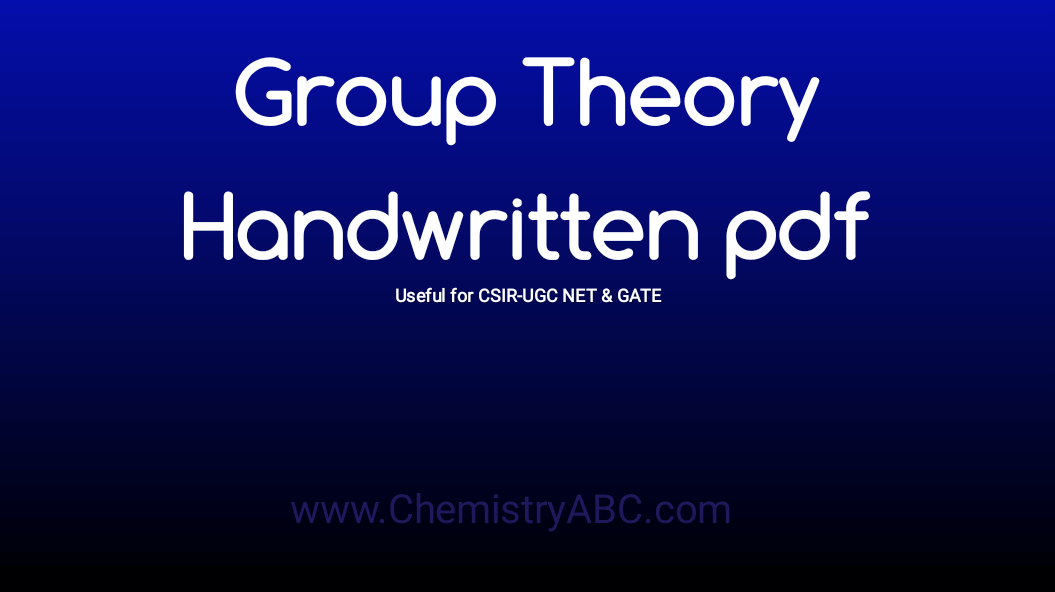CSIR NET: Term Symbols.
Term symbols are used to represent the quantum states of an atom or molecule in group theory. To solve problems related to term symbols, one needs to have a good understanding of the basics of quantum mechanics and group theory. Here are some examples of CSIR NET questions on group theory and term symbols along with their solutions:
Example 1: Consider the following electron configuration of an atom:
1s2 2s2 2p6 3s2 3p6 4s1
Determine the term symbol for the ground state of the atom.
Solution:
The electronic configuration indicates that the atom has a single valence electron in the 4s orbital. The total angular momentum quantum number, J, is given by the sum of the orbital angular momentum quantum number, L, and the spin angular momentum quantum number, S. Since the 4s orbital has zero orbital angular momentum (L=0), the total angular momentum quantum number is equal to the spin quantum number (J=S). The spin quantum number can be either +1/2 or -1/2, depending on the direction of spin. Therefore, the term symbol for the ground state of the atom is 2S+1/2.
Example 2: Consider the following electronic configuration for a diatomic molecule:
σ1s(1) σ1s(1) σ2s(2) σ2s(2) π2px(2) π2py(2)
Determine the term symbols and their degeneracies.
Solution:
The sigma orbitals are spherically symmetric, and the pi orbitals are symmetric about the molecular axis. Therefore, the molecular point group is D∞h. The total angular momentum quantum number for each electron pair can be obtained by adding the angular momentum quantum numbers of each individual electron in the pair. The degeneracy of a term is given by 2J+1, where J is the total angular momentum quantum number.
The possible term symbols for the electronic configuration are:
^1Σg+: This term arises from the bonding electrons in the sigma 1s and sigma 2s orbitals, which have a total angular momentum quantum number of zero.
^3Σg-: This term arises from the antibonding electrons in the sigma 1s and sigma 2s orbitals, which have a total angular momentum quantum number of one.
^1Σu+: This term arises from the bonding electrons in the pi orbitals, which have a total angular momentum quantum number of zero.
^3Σu-: This term arises from the antibonding electrons in the pi orbitals, which have a total angular momentum quantum number of one.
The degeneracies of the terms are:
^1Σg+: 2(0)+1=1
^3Σg-: 2(1)+1=3
^1Σu+: 2(0)+1=1
^3Σu-: 2(1)+1=3
Therefore, the term symbols and their degeneracies are:
^1Σg+: Non-degenerate
^3Σg-: Triply degenerate
^1Σu+: Non-degenerate
^3Σu-: Triply degenerate
These are some examples of questions related to term symbols in group theory that could appear in the CSIR NET exam. To solve these types of questions, it is essential to have a good understanding of the basics of quantum mechanics and group theory, including the calculation of total angular momentum quantum numbers and term symbol degeneracies.
Quantum Mechanics Basics.
Quantum mechanics is a branch of physics that deals with the behavior of matter and energy on a microscopic level. It is a complex and fascinating field that has revolutionized our understanding of the physical world. One of the most important concepts in quantum mechanics is group theory, which provides a powerful tool for understanding the symmetries of physical systems. In this blog post, we will explore the basics of quantum mechanics and group theory, including the calculation of total angular momentum quantum numbers and term symbol degeneracies.
Quantum Mechanics Basics
Quantum mechanics is based on the concept of wave-particle duality, which means that particles can exhibit both wave-like and particle-like behavior. This concept is reflected in the Schrödinger equation, which describes the behavior of quantum particles in terms of wave functions. The wave function of a quantum particle is a mathematical function that describes the probability of finding the particle in a particular state.
The behavior of quantum particles is governed by a set of fundamental principles, including the uncertainty principle, which states that the more precisely the position of a particle is known, the less precisely its momentum can be known, and vice versa. Another important principle is the principle of superposition, which states that a quantum particle can exist in multiple states simultaneously.
Group Theory
Group theory is a branch of mathematics that deals with the study of symmetry. It provides a powerful tool for understanding the symmetries of physical systems and their effects on the behavior of quantum particles. In quantum mechanics, the symmetries of a system are described by a set of operators that preserve the Hamiltonian of the system.
The operators that describe the symmetries of a system are called symmetry operators. These operators form a group, which is a mathematical object that consists of a set of elements and a binary operation that combines two elements to form a third element. The elements of a group represent the different symmetry operations that can be performed on a system, and the binary operation represents the composition of two symmetry operations.
Total Angular Momentum Quantum Numbers
In quantum mechanics, angular momentum is a measure of the rotation of a quantum particle around an axis. The total angular momentum of a system is described by a set of quantum numbers, including the orbital angular momentum quantum number l and the spin quantum number s. The total angular momentum quantum number J is defined as the sum of the orbital and spin angular momentum quantum numbers:
J = l + s
The total angular momentum quantum number J determines the behavior of quantum particles in a magnetic field. The magnetic moment of a quantum particle is proportional to its total angular momentum quantum number J.
Term Symbol Degeneracies
In quantum mechanics, the energy levels of a system are described by term symbols, which are shorthand notations that represent the quantum numbers of the energy levels. The term symbol of an energy level is represented by a letter that indicates the total angular momentum quantum number J, followed by a subscript that indicates the value of the orbital angular momentum quantum number l.
Term symbols can be degenerate, which means that multiple energy levels can have the same term symbol. The degeneracy of a term symbol is determined by the possible values of the spin quantum number s. The degeneracy of a term symbol is given by the formula:
(2J+1)(2l+1)
where J is the total angular momentum quantum number and l is the orbital angular momentum quantum number.
Conclusion
In conclusion, quantum mechanics and group theory are two essential concepts in physics that provide a powerful tool for understanding the behavior of quantum particles. Total angular momentum quantum numbers and term symbol degeneracies are important concepts that are used to describe the behavior of quantum particles in magnetic fields and the energy levels of physical systems. By understanding these concepts, we can gain a deeper appreciation for the complexity and beauty of the physical world
After accessing previous papers of CSIR NET chemical sciences. Here we provided some practice problems related to total angular momentum quantum numbers and term symbol degeneracies that you can use to test your understanding of the topic:
Calculate the total angular momentum quantum number J for an electron with l=2 and s=1/2.
Calculate the term symbol for an energy level with l=1, s=1/2, and J=3/2.
What is the degeneracy of the term symbol 4F?
Calculate the total number of energy levels corresponding to the term symbol 5P.
What is the degeneracy of the term symbol 3D?
These problems can help you practice applying the concepts of total angular momentum quantum numbers and term symbol degeneracies to solve problems. You can check your answers with the solutions provided in the answer key or with the help of a qualified tutor or instructor.
Solutions of group theory problems
Here are the solutions to the problems I provided earlier:
J = l + s = 2 + 1/2 = 5/2
The term symbol is represented by a letter that indicates the total angular momentum quantum number J, followed by a subscript that indicates the value of the orbital angular momentum quantum number l. In this case, J = 3/2, and l = 1. We can represent the term symbol as 2D3/2.
The degeneracy of the term symbol 4F is given by the formula (2J+1)(2l+1), where J = 4 and l = 3. Plugging in these values, we get (2(4)+1)(2(3)+1) = 45. Therefore, the degeneracy of the term symbol 4F is 45.
The term symbol 5P corresponds to an energy level with J = 1/2 and l = 1. The degeneracy of this term symbol is given by (2J+1)(2l+1) = (2(1/2)+1)(2(1)+1) = 6. Therefore, there are 6 energy levels corresponding to the term symbol 5P.
The term symbol 3D corresponds to an energy level with J = 3/2 and l = 2. The degeneracy of this term symbol is given by (2J+1)(2l+1) = (2(3/2)+1)(2(2)+1) = 15. Therefore, the degeneracy of the term symbol 3D is 15.
I hope this helps! Let me know if you have any further questions in comments or in our YouTube discussion.



